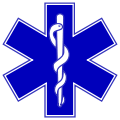Is there such a thing as "secular medicine"? - Part 1
I just read a book entitled The Biblical Guide to Alternative Medicine by Dr. Neil T. Anderson and Dr. Michael Jacobson.[1] It attempts to give some form of guidance to Christians for determining which forms of medicine are acceptable to Christians, and which ones Christians should avoid. The authors put it this way:
The invasion of … unbiblical medical philosophies and practices into the Church may be the biggest threat to our spirituality in the twenty-first century. We routinely come across Christians who have subjected themselves to pseudomedical practices that leave them in spiritual bondage.[2]
While they don’t elaborate in this book as to kind of spiritual bondage they are referring to, it is clearly a warning. The problem is that the whole book is lacking even one form of medicine that isn’t unbiblical in some way and, hence, according to what they say above, a potential threat to Christian spirituality. They state clearly that no existing form of medicine fits the criteria of evaluation they provide – even mainstream, Western medicine is one of these unbiblical invaders. At the same time, they provide a confusing message that allows for some Christians to participate in all forms of medicine they evaluate in this book, even those they consider spiritually dangerous.
The comment “any harbor in a storm” very much applies here. When suffering is great enough, relief is desperately welcomed no matter the source of the relief or the cost. This is not much different from African and Asian Christians going to witchdoctors for cures simply because they work when Western medicine fails, and relief is all that matters. What is of greater concern, however, is that many Christians aren’t even aware of the spiritual bondage Anderson and Jacobson are talking about, but for this series of posts, I want to address only the spiritual roots of Western medical practice rather than the consequences.
On the back cover, the authors – or publishers – make four statements which I will list here:
Every system of medicine is founded on a religious system of thought.
No system of medicine can claim Christianity as its birthright. For any given illness every person must discern which approach is best for them in light of biblical revelation and individual needs.
Despite the popular notion that the word “holistic” is a New Age concept, biblical medicine is definitely wholistic – and should be thought of and discerned as such.
Western medicine is not infallible and must be evaluated using the same criteria as other forms of medicine.[3]
The first two statements will likely come as a surprise to most of us. We can’t see the pagan religious foundations of Western medicine because it has become very secularized, and we have assumed it to be reasonably Christian. The pagan symbols are so ubiquitous that we hardly notice them anymore, certainly not as pagan.
The Caduceus and Rod of Asclepius 
If you doubt this, consider the caduceus – the staff having wings and two snakes wrapped around it in a double-helix that appears in pharmacies, on ambulances, in hospitals and on pins worn by medical practitioners – the caduceus is found basically all over the medical profession.
I have heard some Christians say it is the bronze serpent made by Moses to heal the Israelites when they were bitten by a venomous snake. All the Israelites had to do was look at the bronze (“fiery” in the KJV) serpent and they would live.[4] Centuries later, Hezekiah had to destroy the serpent because the people were making sacrifices to it,[5] no doubt to try to regain some of its original healing power – perhaps beyond the healing of snake bites. Comforting as it might be for Jews and Christians to believe the caduceus is a memorial of Moses’ serpent, it is a false comfort.
Every source I’ve found thus far says the caduceus is from classical mythology. It is the rod, wand or staff of Hermes or Mercury, depending on whether you’re talking Greek or Roman mythology, respectively. The symbol with the single snake is the rod of Asclepius,[6] the Greek and Roman god of healing. The rod of Asclepius is generally used by professional associations whereas the wand of Hermes is used more often commercially. This isn’t hard and fast – I guess it’s a matter of taste.[7]
The reason for the rod of Asclepius being a symbol of medicine will become clear later. The wand of Hermes/Mercury is not so clear. The association seems to come from alchemy which later became chemistry and chemical pharmacy. Hermes was traditionally considered a master of alchemy whose purported works were passed down in the Hermetic Corpus, but this is speculatio" n on my part at this time. Details will have to await another post. However, Keith Blayney agrees with this assessment and adds the following:
n on my part at this time. Details will have to await another post. However, Keith Blayney agrees with this assessment and adds the following:
The link between the caduceus of Hermes (Mercury) and medicine seems to have arisen by the seventh century A.D., when Hermes had come to be linked with alchemy. Alchemists were referred to as the sons of Hermes, as Hermetists or Hermeticists and as "practitioners of the hermetic arts". There are clear occult associations with the caduceus.[8]
The Hippocratic Oath
Consider also the Hippocratic Oath sworn by new doctors, at least in its older, probably original form. I won’t cite it all here, except to quote the first part:
I swear by Apollo, Asclepius, Hygieia, and Panacea, and I take to witness all the gods, all the goddesses, to keep according to my ability and my judgment, the following Oath. …
Apollo was also a healing god of the Greeks, father of Asclepius. Hygieia and Panacea were the daughters of Asclepius. Notice the similarity of Hygieia to the word hygiene. Hygieia was the “goddess of health, cleanliness and sanitation.”[9] Panacea was the goddess of cures. Hygieia and Panacea had brothers, too, gods of diagnostics and surgery among them.[10] Medicine was a family affair, it seems. So it makes sense that the gods referenced by name would be these four, these being the most prominent healing gods of Greece and Rome throughout the classical period – at least from all my reading on the history of medicine.
Asclepius
Asclepius is a notable case. His cult and his few temples – sites of miraculous healing – presented great challenges to Christianity. Vivian Nutton makes the following observation regarding the prevalence of Asclepius in classical Greece and Rome:
Associations of worshippers of Asclepius are known from across the Greek world from the fourth or third century BC until the third century AD. No other divinity in Classical Greece made so swift or so effective a transition from a mainly local to a pan-Hellenic deity.[11]
We might be tempted to think of this as simply a human or sociological phenomenon, but we, as Christians, must keep in mind that the world is a battle field where the “god of this world [Satan] hath blinded the minds of them which believe not, lest the light of the glorious gospel of Christ, who is the image of God, should shine unto them.”[12] Owsei Temkin illustrates one way this took place:
The healing god Asclepius, whose miracles were part of his official cult, became the main rival of the Christ.[13]
Mary Hamilton elaborates on this:
It is probable that Christianity in supplanting paganism found the work comparatively easy so far as the Olympian gods were concerned. Their aloofness from the practical affairs of man tended to alienate their worshippers, and it was a simple matter to cast off allegiance. A harder task awaited the new religion when it sought to dispossess the chthonian deities whose general beneficence and gifts of healing had bound them closely to the people. Worshippers were attracted and their devotion intensified by tangible benefits conferred and help given in times of stress. The faith thus practically engendered and rewarded proved a stubborn barrier to the onward march of Christianity. Paganism made its last stand in the temples of Serapis and Asklepios, and their powers of resistance were due to the cures performed under their auspices in the name of the god.[14]
Relief from suffering is one of the most powerful inducements to allegiance. One powerful technique in interrogating prisoners of war is to induce suffering and privation and then offer them relief contingent on their cooperation. So it seems this is one powerful tool of Satan as mentioned earlier – “any harbor in a storm.” So it was in the early centuries of the Church – pagans, and even suffering Christians, ran to where the power was found for healing. What makes this situation worse is the close relationship of religion and medicine – even if that religion is today’s secular humanism or scientific atheism.
[1] Anderson, Dr. Neil T. and Dr. Michael Jacobson, The Biblical Guide to Alternative Medicine ( Ventura, CA: Regal Books, 2003).
[2] Ibid., p. 10 – emphasis added.
[3] Ibid., back cover. In all these points, italics are those of the authors/publisher.
[4] Numbers 21:9-10.
[5] 2 Kings 18:4.
[6] There are many variants of spelling that I’ve found: Æsculapius and Asklepios among them. The different spellings depend upon whether the writers are citing Roman or Greek sources or those so inclined, such as writers in different regions.
[8] Blayney, Keith, "The Caduceus vs the Staff of Asclepius (Asklepian)," first published September 2002, revised October 2005.
[11] Nutton, Vivian, Ancient Medicine ( London: Routledge, 2004), p. 106.
[12] 2 Corinthians 4:4.
[13] Temkin, Owsei, Hippocrates in a World of Pagans and Christians (Baltimore: Johns Hopkins University Press, 1991), p. 75.
[14] Hamilton, Mary, Incubation; or, The Cure of Disease in Pagan Temples and Christian Churches (St. Andrews: W.C. Henderson & Sons, University Press, 1906), p. 109 – emphasis added.
Labels: alternative medicine, Asclepius, caduceus, Hippocrates, Hippocratic Oath, Hygieia, medicine, Michael Jacobson, Neil Anderson, Panacea, secular medicine, worldview


0 Comments:
Post a Comment
<< Home